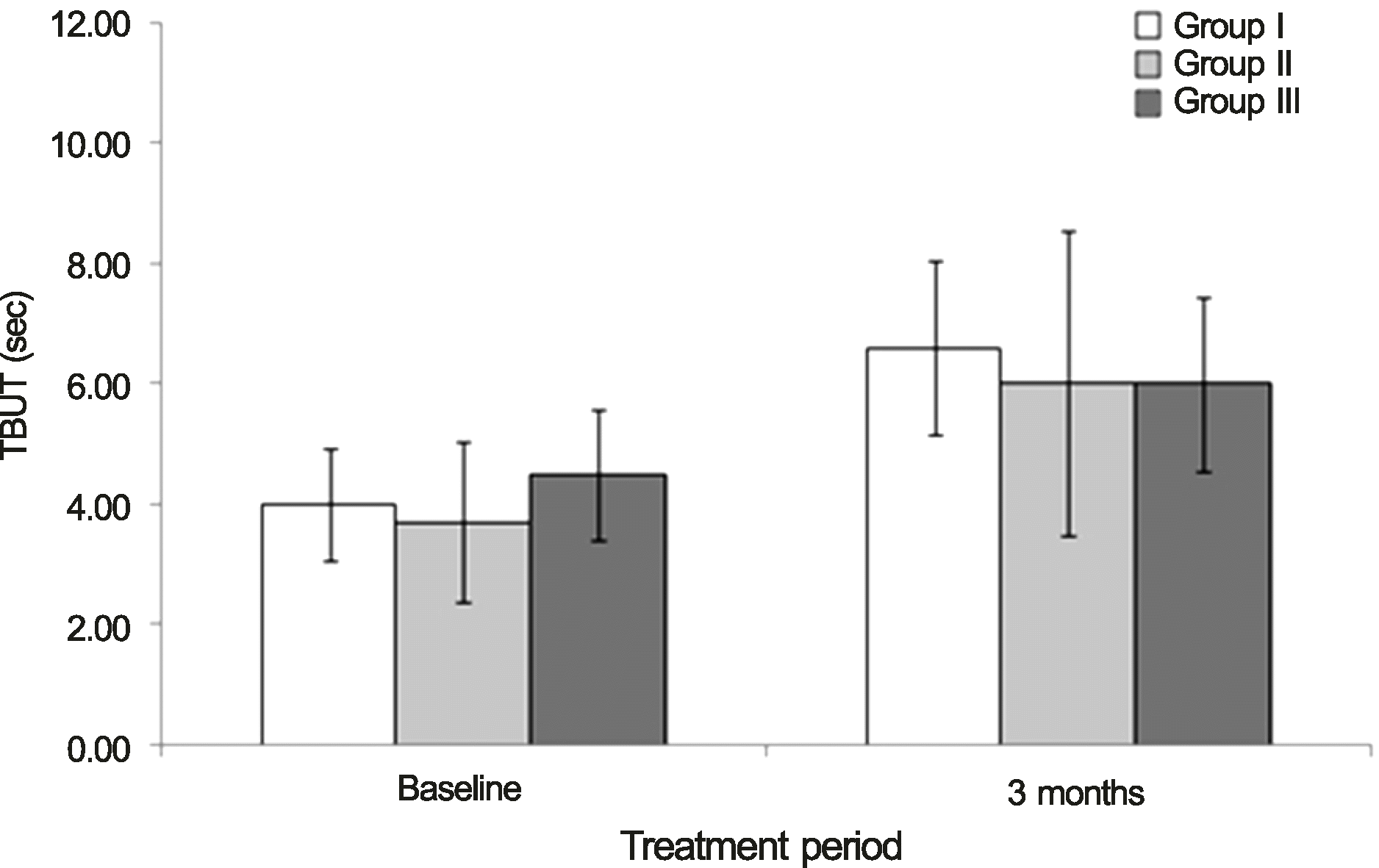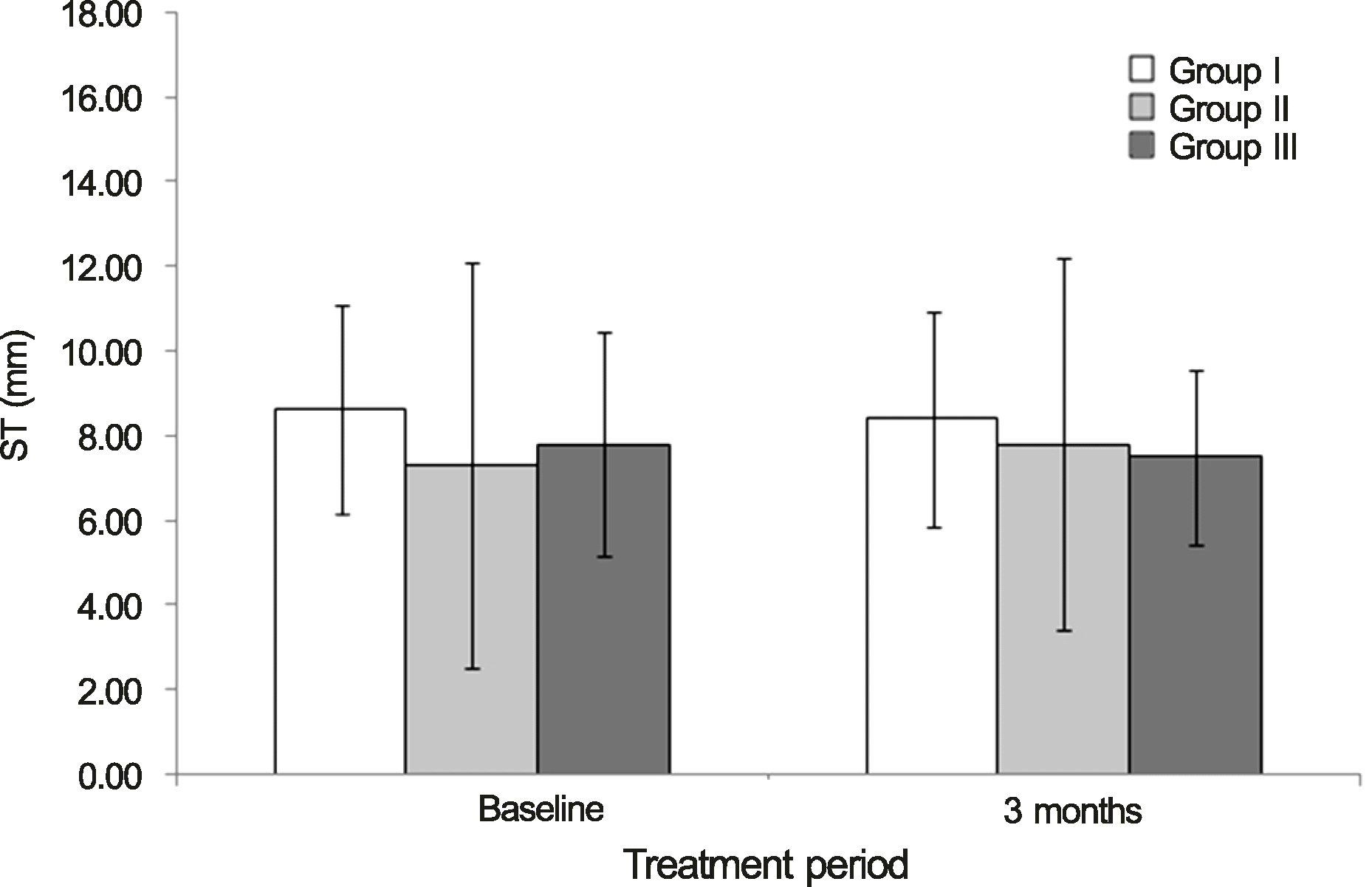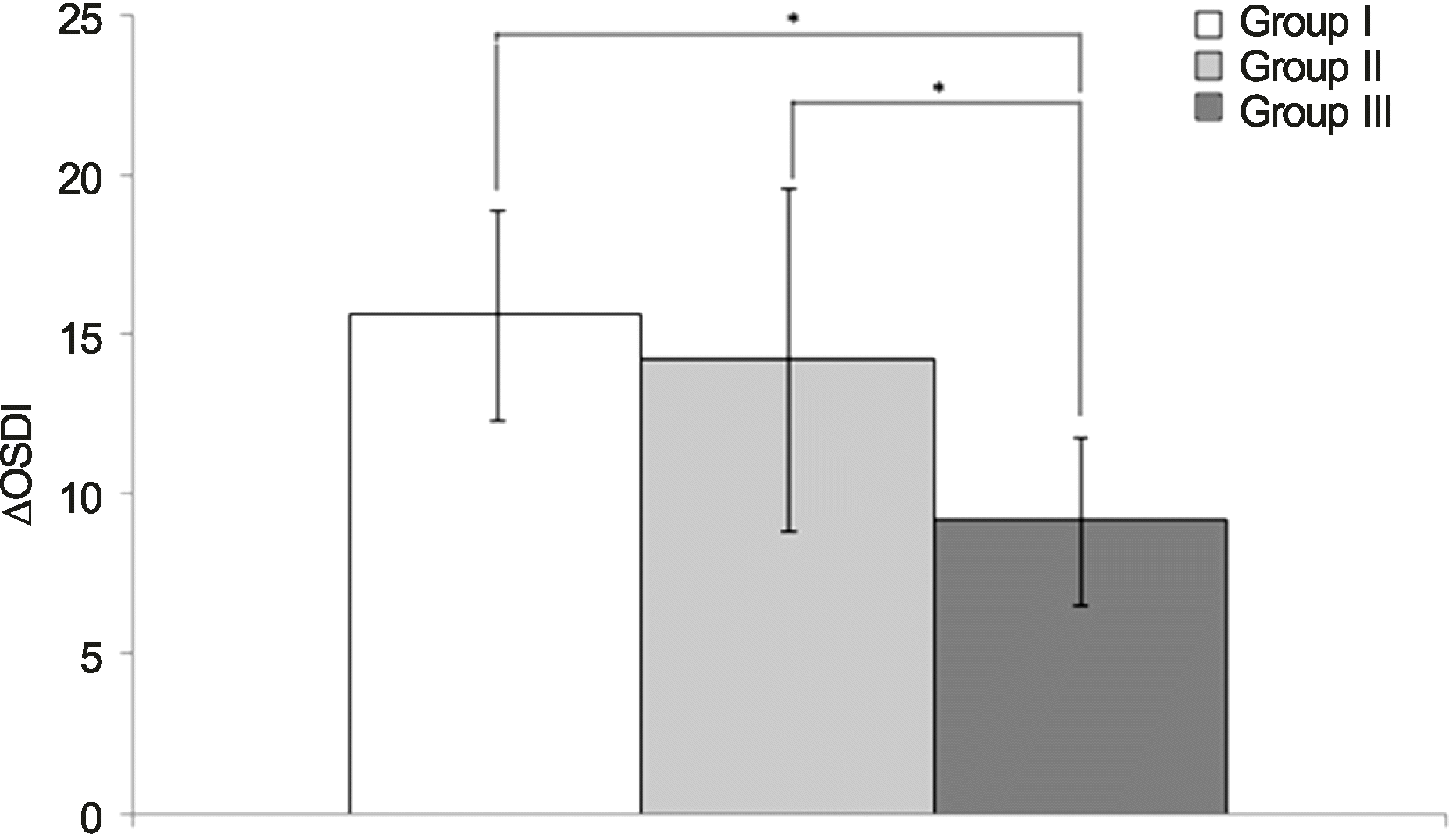Abstract
Purpose
To compare the response of dry eye treatment in patients divided by the degree of lower lid laxity.
Methods
Thirty patients were classified into three groups - normal, moderate and severe, according to the degree of lower lid laxity. Tear break-up time (TBUT), Schirmer test (ST), ocular surface disease index (OSDI) scores and changes in OSDI score in each group were compared before and at 3 months after the treatment.
Results
TBUT, ST and OSDI scores were not different among the three groups at baseline. TBUT improved to 6.60 ± 1.43, 6.0 ± 2.54 and 6.0 ± 1.45 sec in normal, moderate and severe lower lid laxity group, respectively at 3 months after the treatment and no difference among the groups was found. ST scores did not increase after the treatment, while OSDI scores improved to 12.20 ± 1.40, 16.10 ± 4.63 and 20.80 ± 4.52 in each group, respectively and they were significantly different (p = 0.029, 0.029, <0.001, respectively). The response to the dry eye treatment as assessed by changes in OSDI scores was poorer in patients in the severe lower lid laxity group (p = 0.019 vs. moderate laxity group, <0.01 vs. normal group).
Go to : 
References
1. The definition and classification of dry eye disease: report of the Definition and Classification Subcommittee of the International Dry Eye WorkShop (2007). Ocul Surf. 2007; 5:75–92.
2. Shimazaki-Den S, Iseda H, Dogru M, Shimazaki J. Effects of diquafosol sodium eye drops on tear film stability in short BUT type of dry eye. Cornea. 2013; 32:1120–5.

3. Cho BJ, Lee JH, Shim OJ. The relation between clinical manifestations of dry eye patients and their BUTs. J Korean Ophthalmol Soc. 1992; 33:297–302.
4. Nichols KK, Nichols JJ, Mitchell GL. The lack of association between signs and symptoms in patients with dry eye disease. Cornea. 2004; 23:762–70.

5. Rees TD, Jelks GW. Blepharoplasty and the dry eye syndrome: guidelines for surgery? Plast Reconstr Surg. 1981; 68:249–52.
6. Mastrota KM. Impact of floppy eyelid syndrome in ocular surface and dry eye disease. Optom Vis Sci. 2008; 85:814–6.

7. Amano S. MGD Working Group: Definition and diagnostic criteria for meibomian gland dysfunction. J Eye (Atarashii Ganka). 2010; 27:627–31.
8. Dana MR, Hamrah P. Role of immunity and inflammation in corneal and ocular surface disease associated with dry eye. Adv Exp Med Biol. 2002; 506:729–38.

9. Stern ME, Gao J, Siemasko KF, et al. The role of the lacrimal functional unit in the pathophysiology of dry eye. Exp Eye Res. 2004; 78:409–16.

10. Le Q, Ge L, Li M, et al. Comparison on the vision-related quality of life between outpatients and general population with dry eye syndrome. Acta Ophthalmol. 2014; 92:e124–32.

11. Li M, Gong L, Chapin WJ, Zhu M. Assessment of vision-related quality of life in dry eye patients. Invest Ophthalmol Vis Sci. 2012; 53:5722–7.

12. Gonnering RS, Sonneland PR. Meibomian gland dysfunction in floppy eyelid syndrome. Ophthal Plast Reconstr Surg. 1987; 3:99–103.

13. Bron AJ, Tiffany JM, Gouveia SM, et al. Functional aspects of the tear film lipid layer. Exp Eye Res. 2004; 78:347–60.

14. Liu DT, Di Pascuale MA, Sawai J, et al. Tear film dynamics in floppy eyelid syndrome. Invest Ophthalmol Vis Sci. 2005; 46:1188–94.

Go to : 
 | Figure 1.Changes in tear break-up time (TBUT), before and at 3 months after the treatment in eyes grouped by the degree of lower lid laxity. |
 | Figure 2.Changes in Schirmer test (ST) before and at 3 months after the treatment in eyes grouped by the degree of lower lid laxity. |
 | Figure 3.Changes in ocular surface disease index (OSDI) scores before and at 3 months after the treatment in eyes grouped by the degree of lower lid laxity. *Mann Whitney test (significance level is p < 0.05). |
 | Figure 4.Comparison of changes in ocular surface disease index (OSDI) scores between pretreatment and at 3 months after the treatment in eyes grouped by the degree of low er lid laxity. *Mann Whitney test (significance lev el is p < 0.05). |
Table 1.
Demographics and changes in tear break-up time (TBUT), Schirmer test (ST) and ocular surface diseases index (OSDI) scores before and at 3 months after the treatment in eyes grouped by the degree of lower lid laxity
| Parameters |
Groups |
p-value |
||||
|---|---|---|---|---|---|---|
| I (n = 10) | II (n = 10) | III (n = 10) | I & II | II & III | I & III | |
| Age (years) | 55.00 ± 5.29 | 56.70 ± 5.36 | 56.10 ±4.80 | 0.436 | 0.912 | 0.631 |
| Sex (M:F) | 0:10 | 1:9 | 2:8 | 1.000 | 1.000 | 0.474 |
| Treatments (%) | ||||||
| 0.1% Fluorometholon | 50 | 60 | 60 | 1.000 | 1.000 | 1.000 |
| 0.05% Cyclosporine A | 10 | 20 | 10 | 1.000 | 1.000 | 1.000 |
| Tetracyclin oint + Blephasol® | 0 | 20 | 40 | 0.474 | 0.628 | 0.087 |
| MGD | 1.20 ± 0.42 | 1.90 ± 0.74 | 2.00 ± 0.00 | 0.043† | 0.739 | 0.002† |
| TBUT (sec) | ||||||
| Baseline | 4.00 ± 0.94 | 3.70 ± 1.34 | 4.50 ± 1.08 | 0.739 | 0.218 | 0.315 |
| 3 months | 6.60 ± 1.43 | 6.00 ± 2.54 | 6.00 ± 1.45 | 0.631 | 0.684 | 0.436 |
| p-value | 0.004* | 0.011* | 0.010* | |||
| ΔTBUT | 2.60 ± 0.84 | 2.30 ± 1.57 | 1.50 ± 1.20 | 0.739 | 0.218 | 0.051 |
| ST (mm) | ||||||
| Baseline | 8.60 ± 2.46 | 7.30 ± 4.79 | 7.80 ± 2.66 | 0.105 | 0.247 | 0.529 |
| 3 months | 8.40 ± 2.55 | 7.80 ± 4.39 | 7.50 ± 2.07 | 0.353 | 0.631 | 0.481 |
| p-value | 0.557 | 0.496 | 0.457 | |||
| ΔST | −0.20 ± 2.15 | 0.50 ± 2.32 | −0.30 ± 1.83 | 0.631 | 0.579 | 0.853 |
| OSDI | ||||||
| Baseline | 27.80 ± 4.44 | 30.30 ± 7.99 | 30.00 ± 4.85 | 0.796 | 1.000 | 0.579 |
| 3 months | 12.20 ± 1.40 | 16.10 ± 4.63 | 20.80 ± 4.52 | 0.029† | 0.029† | <0.001† |
| p-value | 0.005* | 0.005* | 0.005* | |||
| ΔOSDI | 15.6 ± 3.31 | 14.2 ± 5.33 | 9.2 ± 2.62 | 0.529 | 0.019† | <0.001† |




 PDF
PDF ePub
ePub Citation
Citation Print
Print


 XML Download
XML Download